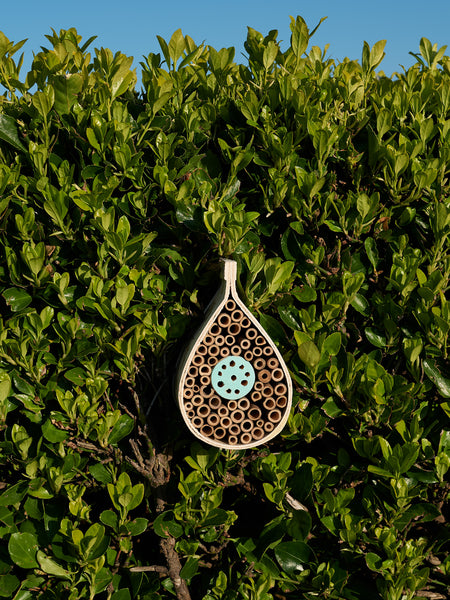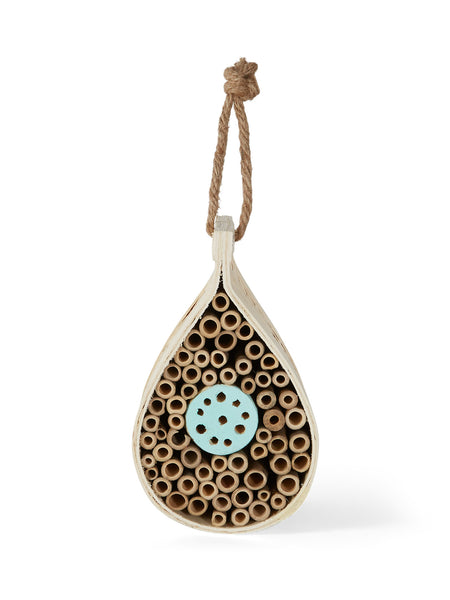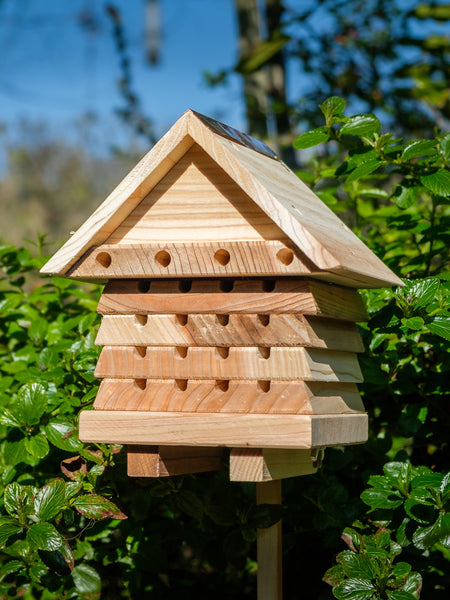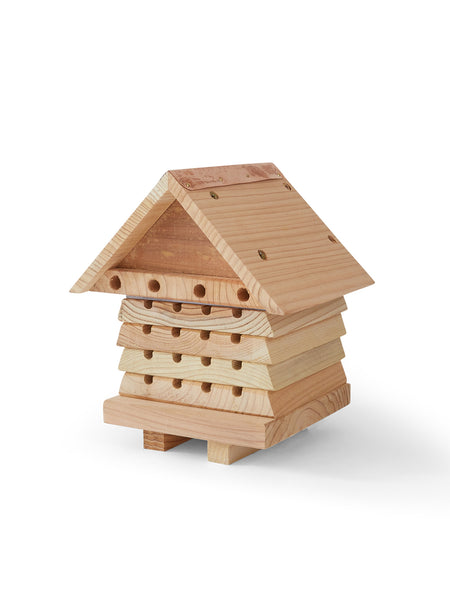The world needs bees! As garden lovers, we can each play an important part in helping them to thrive. Ultimately, what’s good for them is also good for us, so considering what bees need when planning and planting our gardens creates a satisfying ‘win win’ situation. In this short guide, I’m going to offer a few quick and easy tips for masterminding a beautiful, bountiful, bee-friendly garden.
Although we may take bees and other pollinators such as butterflies and hoverflies for granted, to the extent that some might even consider them a nuisance or a danger, they play a vital part in maintaining our quality of life. Bees pollinate around 80% of wildflowers and the majority of the plants we rely on for our food - this enables them to produce fruit, set seed and reproduce successfully. Honeybees also produce honey, which is soothing and delicious as well as offering a number of health benefits. Sadly, pollinators of all kinds are in trouble globally. A decline in their population has been caused by a combination of stresses from diseases and loss of natural habitat to the adverse effects of pesticides and the consequences of climate change.
When we think of bees, two types generally spring to mind - honeybees and bumblebees. There are, in fact, around 270 species of bee that have been recorded in the UK. Most honeybees are kept by beekeepers in colonies of managed hives. Beekeeping is becoming a popular hobby thanks to champions like The British Bee Charity. The remainder of our resident bees is wild, including 25 bumblebee species and more than 220 types of solitary bee. Bumblebees live in social colonies - usually in holes in the ground or tree cavities - while solitary bees tend to nest on their own in walls, dry sunny banks, cliffs, lawns or beneath hedges. Each female builds and provisions her own nest with food - the males play no part in this activity.

A giant bee takes a moment's rest at the Eden Project in Cornwall
The good news is that we can all do our bit to support pollinators through positive actions in our gardens, on our balconies and in shared community spaces. By making a few small, nonintrusive concessions, bees will quickly flourish. There’s no time like the present, so here are a few positive actions that can be taken throughout the year.
Make way for weeds
Overly tidy gardens are generally not wildlife-friendly gardens. Allow a few weeds to grow, leave piles of old sticks and stems in hidden places and create piles of logs discreetly or as a prominent feature. Untidy does not have to mean unsightly: by allowing a few weeds to grow and flower, perhaps in a lawn or a far corner of your garden, you will be providing bees with a familiar source of pollen and nectar. For the neat and tidy gardener, this will be anathema but, fortunately, we’re all becoming more accepting of a shaggier, lower-maintenance style that welcomes wild creatures.

Dandelions are much loved by many types of bees
Plant for pollinators
The easiest thing any of us can do is plant more pollinator-friendly flowers - hardly a hardship unless you are a die-hard foliage fan or severe hayfever sufferer. Bees forage from all sorts of different flower types so there are very few rules here. However, it’s worth noting that double flowers, where the pollen-covered stamens are less accessible or perhaps not visible at all, are not as useful to bees as one might imagine. That said, we frequently find bees sleeping within our dahlia blooms on hot days so they are not entirely without purpose. Flowers with large, flat open centres are appealing to some kinds of bees, whilst others prefer to probe tubular blooms with their long tongues. If you have a spare patch of ground in your garden it’s a great idea to sow an annual flower meadow in April or May. Alternatively, you can plant an area of lawn with spring-flowering bulbs and wildflower plug plants to create a more enduring meadow, cutting it only in the autumn and winter so that the flowers can grow, bloom and set seed.
Here are ten bee favourite flowers:
- Borage (Borago officinalis) - an annual herb with blue, star-shaped, edible flowers.
- Cosmos (Cosmos bippinatus) - an old favourite annual. Daisy-like flowers come in innumerable colours from white through to deep red, orange and yellow.
- Globe thistle (Echinops ritro) - a sturdy perennial thistle that produces perfectly formed globes of tiny flowers in shades of blue or white.
- Honeysuckle (Lonicera pericylmenum) - a beautiful native climber with scented flowers adored by bees with long tongues.
- Lavender (Lavandula angustifolia) - joyfully fills a period during June and July when there are surprisingly few good bee-friendly flowers available to forage from.
- Sedum (Sedum spectabile) - I have vivid childhood memories of bees and butterflies feasting on the flat, pinkish-red heads of sedum. Perennial and easy to grow.
- Snapdragon (Antirrhinum majus) - a great favourite of bumblebees. Watch them hang precariously on the flower’s lower lip to open the bloom and crawl inside. A fascinating flower for children to grow. Reds and yellows are especially appealing for insects.
- Argentinian vervain (Verbena bonariensis) - a towering yet gauzy presence and a must for both contemporary and cottage gardens. Produces tall stems topped with purple flowers.
- Viper's bugloss (Echium vulgare) - a native biennial producing blue flowers packed with nectar from June to September. It does well in the sun in dry, well-drained soils.
- Wild marjoram (Origanum vulgare) - not only a stupendously useful herb, essential in Italian cookery, but also a magnet for bees and butterflies. Good for naturalising in grass.
There are so many more pollinator-friendly flowers so just plant what you love and the bees will surely come!

Sedums can be given the 'Chelsea Chop' to encourage them to flower for longer
Give them shelter
We are generally completely unaware of where bees nest. For the majority of kinds, it’s not in a hive but in tiny holes in the ground, between bricks or in tree trunks. Watch them carefully and they may give their home address away! You can help solitary bees find shelter by providing them with a home, either in the form of a pre-fabricated ‘hotel’ or by constructing one of your own. A combination of bricks, tiles, dried grasses, twigs, hollow stems and logs stacked up securely in a quiet part of the garden is ideal and costs nothing to create.

Let them drink
Many of us provide garden birds with a source of water, but what about bees? They need to drink too, especially during dry spells when there are no natural pools of water to sip from. Provided your birdbath is shallow or has some pebbles in it to allow insects to climb out, it will work perfectly well as a water source. Alternatively, you can fill an old saucer with pebbles and top it up with water to create your own bespoke bee drinker. If you have a pond, bees may settle at the water’s edge or on lily leaves to drink. Unlike birds, bees are not particular about having clean water so don’t worry if it looks a little murky. Simply top up the water source whenever the level drops.
Provide a supply of hairs and leaves
Some types of bee use the hairs from plants with furry leaves or small sections of leaf to build the cells within their nests. If you happen to notice that semi-circular pieces have been taken from a plant’s leaf edge then that could very well be the result of a visit from a leafcutter bee, of which there are seven species in the UK. Apart from altering the plant’s appearance, the actions of these bees have no impact on the plant and will be helping to make a new generation of bees feel warm and cosy somewhere in your garden. Wool carder bees will use the soft hair from plants like lambs’ ears (Stachys byzantina), great mullein (Verbascum thapsus) and yarrow (Achillea millefolium) to furnish their nests.

Hairs on the leaf surface of lamb's ears are used by carder bees. (Image Frank Vincentz)
Park the pesticides
However well-intentioned and carefully used, pesticides cannot be good news for pollinators. It’s better to accept the presence of ‘pests’ and acknowledge that they can help develop a natural balance in the garden. They can even provide a source of food for pollinators, for example, aphids are consumed by many species of hoverfly larvae. Prevent and reduce pests and diseases through good husbandry. If problems persist, use biological rather than chemical controls.
There’s so much that can be said about bees and all other types of pollinators that whole books have been devoted to the subject. Hopefully, this short article will give you somewhere to start or a few new ideas about creating a more bee-friendly environment in your garden. Dan.






